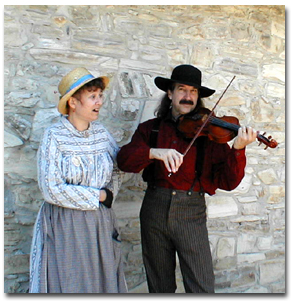In Praise of the Wrapper
Many living history programs, which focus on domestic life in the second half of the 19th Century are faced with the dilemma of women who want to, or are supposed to be in 19th Century costume, but who are not willing or able to wear the elaborate underpinnings that go with fashionable ladies' attire, such as corsets, petticoats, bustles and the like.
Many more who are willing to give it a try lack the sewing skills required to produce one of these rather complex dresses.
There is a solution: it is called the "wrapper".
The 19th Century wrapper is a house dress. It was worn to do the hard work that was so much a part of the life of 19th Century women. Floors need to be scrubbed, cows milked, laundry washed, children chased, meals prepared etc. etc., and none of this is really possible for a woman all trussed up in a corset and bustle. Working class women on the farm or in the tenement would frequently only have a wrapper, and not even possess a fashionable dress. Middle class women, who would wear fashionable finery to go out visiting, would wear a wrapper to do the housework. While most middle class families had maids of all work to help out, the lady of the house also did a lot of drudge work, and she did it in a wrapper. The wrapper, interestingly enough, got more fashionable as the century progressed, so that by the 1890s, ladies were entertaining other ladies in "Tea Wrappers". |
 |
An other benefit of the wrapper for house museums and the like is that, unlike fashionable dresses which have to really fit well, the wrapper is cut very loose. It can even function as a maternity dress when you remove the belt or apron. Therefore, it is ideal to keep in stock to be issued to docents of all sizes.
An alternative name for the wrapper (which wasn't used in the 19th Century) was the "Prairie Dress".
So, I would strongly suggest for the female docent who wants to be comfortable and have a dress that's easy to make and take care of, get yourself a wrapper.
Here is the Folkwear Pattern for a typical late Century wrapper.







Comments
Are you sure about this? The lectures I've heard (I admit that I haven't done the research to check out the original sources) have said that _everyone_ wore underpinings, at least every _decent_ woman. There were corsets under Regency dresses, and a maid could be dismissed for not wearing a corset. I believe that this was why the bralessness of the 1960s was so shocking. Can you cite some references? I agree that the shapelessness of the the wrapper meant you didn't have to corset very tightly, didn't have to have the most up-to-date style of corset, and didn't have to buy new clothes (though you might need a new corset) for pregnancy, but I was pretty sure that they wore _something_ underneath, and that that something more closely resembled a corset than it did what we wear today.
Looking forward to seeing your research.
Posted by: Bridget Landry | May 12, 2006 02:38 PM
There are a few issues here:
First, this piece was primarily aimed at the numerous modern women who want to wear 19th Century costume, but don't want to wear corsets. This was to present a historically defensible alternative.
Second, the biggest mistake most of those who address Victorian sensibilities make is that they focus on the middle class--the people for whom etiquette books were written, and the ones who wore fashionable corset-required attire (and who required their maids to keep up appearances). The vast majority of Americans however lived on farms or in tenements and lived a life of compromises.
I will not assert that working class women did not wear corsets--of course they did. There is plenty of photographic evidence for it. I will however assert that not all working women wore corsets at all times. It takes some digging, but there is photographic evidence for the lack of corseting-- especially among the rural working women.
It should be noted though that it was pretty clear that corseting was considered to be part of "proper dress" of the sort one would wear to be photographed--which is also why photos of wrappers are hard to come by.
And of course, there are lots of photographs, especially of skinny women (as working women often were) where the presence or absence of a corset is not conclusively evident.
Here are a few citations:
Dressed for the Photographer by Joan Severa, Kent State U. Press.
Pg 278
Pioneer Women: Voices from the Kansas Frontier by Joanna Stratton.
Illustration pages between pg 160 and 161. See pictures captioned "Neighbors May Terry...", "Frontier women often made..." and "A Kansas washday".
Note that in this same batch, there are also pictures of women who quite clearly ARE wearing corsets under their modest frontier frocks.
An assertion, for any period of history, that all people at all times did a certain thing, is a pretty high bar to reach. I am simply asserting that the exigencies of life produced exceptions to the corset rule.
I do not include scans of these photographs, as I do not hold the copyright.
Walter Nelson
Posted by: Walter Nelson | May 13, 2006 09:42 AM
A few good pictures of elegant silk wrappers can be seen in "From Queen To Empress, Victorian Dress 1837-1877" put out by the Metropolitan Museum of Art, New York. Some interesting commentary on the garment as well.
Posted by: Veronica | May 15, 2006 11:46 AM